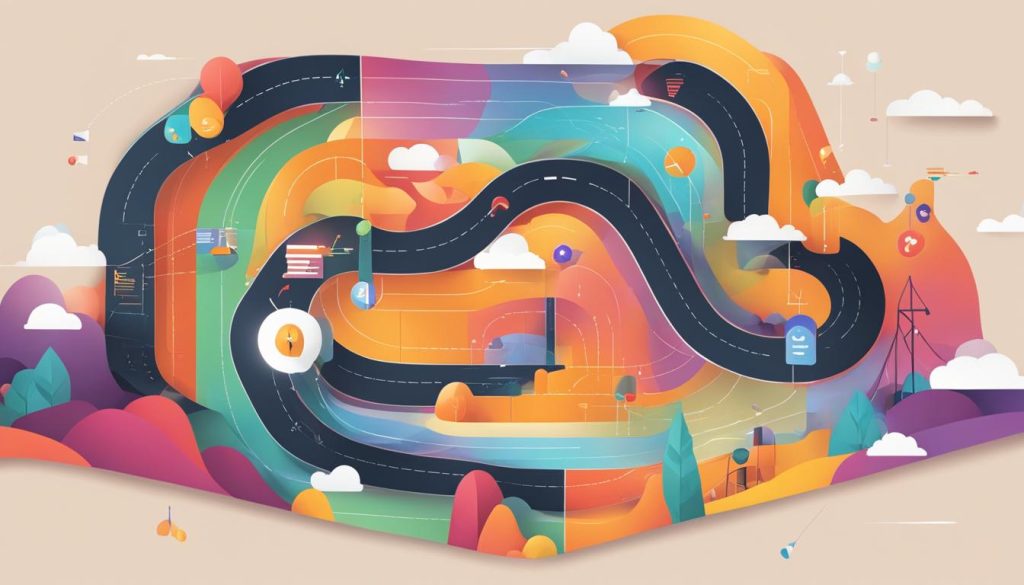Building a strong and lasting connection with your audience is crucial in today’s digital landscape. To create meaningful connections and foster emotional engagement, navigating the emotional landscape with empathy and resilience is essential. In this article, I will explore six important milestones to build a durable rapport fortified by emotional storytelling, website design, digital experience, and user interface.
These milestones will guide you in understanding the power of emotions and how they can be harnessed to create a captivating and impactful user experience. By incorporating the principles of emotional storytelling, designing emotionally resonant websites, and prioritizing the user’s emotional journey, you can forge deeper connections and establish a strong emotional bond with your audience.
Key Takeaways:
- The emotional landscape plays a significant role in building resilient rapport.
- Emotional storytelling and website design are powerful tools for creating meaningful connections.
- Understanding the digital emotional experience is crucial in fostering connection in the virtual world.
- Emotional branding and web content crafting enhance emotional connections with the audience.
- Empathy and resilience are essential in navigating the emotional landscape.
Understanding the Emotional Landscape
The emotional landscape is a complex terrain that encompasses a wide range of feelings and experiences. To effectively navigate this landscape, it is crucial to understand the role of emotions and how they can be visually represented. This is where emotional graphics and graphic design for emotions come into play.
Emotional graphics are powerful tools that allow us to convey and elicit specific emotional responses through visual elements. We can create a visual language that evokes the desired emotions by utilizing colors, shapes, and imagery that resonate with our audience.
Emotional graphics provide a direct and immediate experience of emotions, bypassing the need for language or conscious interpretation.

Graphic design for emotions takes this concept further by incorporating emotional graphics into various mediums, such as websites, advertisements, and social media posts. It involves strategically placing emotional graphics within a design to enhance the overall emotional impact.
The Power of Visual Representation
Visual representation plays a crucial role in shaping our emotional responses. A well-designed emotional graphic can instantly convey complex emotions, capturing viewers’ attention and interest.
By understanding the emotional landscape and effectively utilizing emotional graphics and graphic design for emotions, we can create visually engaging content that resonates deeply with our audience, fostering a stronger connection and emotional engagement.
| Emotional Graphics | Graphic Design for Emotions |
|---|---|
| Conveys emotions directly | Enhances emotional impact |
| Captures attention and interest | Fosters a stronger connection |
| Creates a visual language | Resonates deeply with the audience |
Emotional Storytelling: Connecting Through Narrative
Emotional storytelling is a powerful tool that allows individuals to forge deep connections and create lasting impressions. By utilizing the narrative form, I am able to evoke specific emotions and engage my audience on a profound level. I can transport my readers to different emotional landscapes through carefully crafted stories, eliciting empathy and understanding. Whether it’s a personal anecdote or a fictional tale, emotional storytelling has the ability to captivate and resonate with people in a way that traditional communication methods cannot.
One of the key benefits of emotional storytelling is its ability to build emotional branding. By strategically incorporating emotional narratives into brand messaging, companies can connect strongly with their target audience. Emotions are a powerful driver of consumer behavior, and by appealing to the emotions of their customers through storytelling, brands can create a sense of loyalty and trust. In fact, studies have shown that brands that evoke positive emotions in their customers are more likely to have higher customer satisfaction and loyalty.
Emotional web content is another area where storytelling plays a crucial role. I can engage readers and inspire them to take action by crafting compelling stories in web content. Whether it’s a blog post, an article, or a website copy, incorporating storytelling techniques can make the content more relatable and memorable. This, in turn, can lead to higher engagement and conversions. When crafting emotional web content, it’s important to understand the target audience and tailor the story to resonate with their emotions and experiences.
| Emotional Storytelling | Emotional Branding | Emotional Web Content |
|---|---|---|
| Uses narratives to evoke specific emotions and engage the audience | Utilizes emotional narratives to create a strong connection with the target audience | Crafts compelling stories in web content to increase engagement and conversions |
| Creates lasting impressions and fosters empathy and understanding | Builds loyalty and trust through emotional connections with customers | Makes web content more relatable and memorable |
| Elicits positive emotions and influences consumer behavior | Leads to higher customer satisfaction and loyalty | Inspires readers to take action |
Emotional Website Design: Creating an Engaging User Experience
When it comes to building a successful online presence, emotional website design plays a crucial role in creating an engaging user experience. By incorporating elements such as color, typography, and imagery, designers have the power to evoke specific emotions and make a lasting impression on visitors.
One key aspect of emotional website design is the use of color. Different colors can evoke different emotions and set the overall tone of a website. For example, warm colors like red and orange can create a sense of excitement and passion, while cool colors like blue and green can promote a feeling of calmness and tranquility.
The use of typography is another important consideration in emotional website design. Fonts can convey a variety of emotions, from elegance and sophistication to playfulness and creativity. By carefully selecting the right font, designers can enhance the overall user experience and communicate the desired emotional message.
Furthermore, imagery plays a vital role in creating an emotional connection with users. High-quality images that resonate with the target audience can help evoke specific emotions and make the website more relatable. Whether it’s a powerful photograph, an inspiring illustration, or a captivating video, visuals have the power to elicit strong emotional responses.
Table: Examples of Emotional Website Design Elements
| Element | Emotion |
|---|---|
| Color | Warm colors evoke excitement and passion, while cool colors promote calmness and tranquility. |
| Typography | Fonts can convey elegance, playfulness, or other desired emotions. |
| Imagery | High-quality visuals that resonate with the target audience can evoke strong emotional responses. |
Overall, emotional website design goes beyond aesthetics and focuses on creating a meaningful and immersive user experience. By strategically incorporating elements like color, typography, and imagery, designers can elicit specific emotions and build a strong emotional connection with visitors. This connection not only enhances user engagement but also leaves a lasting impression that can contribute to the success of a website.

Digital Emotional Experience: Fostering Connection in the Virtual World
The digital landscape has transformed the way we connect and engage with others. Fostering emotional connections is crucial to building meaningful relationships in this virtual realm. Through digital emotional experiences, we can evoke specific emotions and create a powerful connection with users.
Emotional web design is a key component of the digital emotional experience. By carefully crafting the visual elements, such as color palettes and imagery, we can create a website that resonates with users on an emotional level. This design approach allows us to engage users in a more immersive and impactful way, enhancing their overall experience.
Equally important is the role of emotional user interface (UI) in fostering connection in the virtual world. By designing interfaces that evoke specific emotions through elements like animation, micro-interactions, and intuitive navigation, we can create a seamless and emotionally resonant user experience. This approach captivates users and encourages them to stay and explore further.
Through digital emotional experiences, we have the opportunity to foster genuine connections and create a lasting impact on users. Combining emotional web design and UI can enhance the user’s journey, making it more immersive, engaging, and emotionally fulfilling.
| Benefits of Digital Emotional Experience | Examples |
|---|---|
| 1. Increased user engagement | Engaging interactive elements that encourage users to explore and interact with the website. |
| 2. Enhanced brand perception | A visually appealing website design that aligns with the brand’s emotions, creating a positive impression. |
| 3. Improved conversion rates | Emotionally resonant call-to-action buttons and persuasive messaging that drive users to take desired actions. |
| 4. Stronger emotional connection | Personalized experiences that evoke specific emotions and create a sense of connection between the brand and the user. |
By prioritizing the digital emotional experience, we can create a virtual world that fosters genuine connections and leaves a lasting impression. Through emotional web design and emotional UI, we can evoke specific emotions, engage users on a deeper level, and build a resilient rapport that goes beyond the boundaries of the digital realm.
Emotional Branding: Building a Strong Emotional Connection
When it comes to building a strong emotional connection with your audience, emotional branding is key. By aligning your brand’s values with emotional storytelling and emotional website design, you can create a lasting impression and foster a sense of loyalty and connection with your customers.
Emotional storytelling allows you to convey your brand’s narrative in a way that resonates with your audience on a deeper level. You can establish a strong emotional connection and leave a lasting impact by evoking specific emotions through your brand’s story. Whether it’s through compelling visuals or captivating narratives, emotional storytelling can help your brand stand out in a crowded market.
Emotional website design is another essential component of building a strong emotional connection. Creating a visually appealing and emotionally resonant website can engage your audience and elicit specific emotional responses. This can be achieved through the strategic use of colors, imagery, and typography, all of which can convey certain emotions and enhance the overall user experience. By designing a website that embodies the emotions your brand wants to evoke, you can create a lasting impression that leaves your audience wanting more.
Emotional branding is about creating an emotional experience that resonates with your audience, evokes a positive emotional response, and builds a connection that goes beyond the transactional. It’s about tapping into the emotions that drive consumer behavior and using them to create a strong and enduring relationship between your brand and your customers.

In conclusion, emotional branding plays a vital role in building a strong emotional connection with your audience. By strategically incorporating emotional storytelling and emotional website design into your brand strategy, you can create a lasting impression and foster a deeper sense of connection and loyalty with your customers.
Emotional Web Content: Crafting Compelling Emotional Messages
Emotional web content is a powerful tool for connecting with audiences on a deeper level. Companies can create a more engaging and impactful online presence by crafting compelling messages that evoke specific emotions. The key to effective emotional web content lies in employing emotional storytelling techniques and aligning the content with the brand’s emotional branding strategy.
When creating emotional web content, it’s crucial to understand the power of storytelling. By telling stories that resonate with the audience’s emotions, brands can create a sense of connection and empathy. Whether it’s through relatable anecdotes, personal experiences, or inspiring narratives, emotional storytelling helps foster a stronger bond between the brand and its target audience.
To ensure that emotional web content aligns with the brand’s emotional branding strategy, it’s essential to consider the intended emotional response. The content should be carefully crafted to achieve the desired effect, Whether to evoke joy, nostalgia, inspiration, or any other emotion. This involves selecting the right words, tone, and imagery that elicit the intended emotional response in readers.

Ultimately, emotional web content serves as a powerful tool for building resilient rapport by connecting with audiences on an emotional level. By employing emotional storytelling techniques and aligning the content with the brand’s emotional branding strategy, companies can create a captivating online experience that leaves a lasting impact on their target audience.
Emotional User Interface: Enhancing the User Experience
In today’s digital landscape, designing user interfaces that evoke specific emotions is essential to creating a truly immersive and engaging user experience. The emotional user interface focuses on incorporating elements such as color, layout, and interactive features that elicit specific emotional responses from the user. By understanding the impact of emotions on user behavior, designers can create interfaces that meet functional needs and resonate on a deeper emotional level.
One key aspect of emotional user interface design is the careful selection of colors. Different colors have the power to evoke specific emotions and create a desired atmosphere. For example, warm colors like red and orange can elicit excitement and energy, while cool colors like blue and green evoke a sense of calm and tranquility. By strategically using colors, designers can set the emotional tone of an interface and guide the user’s emotional experience.
Another important consideration in emotional user interface design is the layout and organization of elements within the interface. A well-designed layout can create a sense of harmony and balance, contributing to a positive emotional experience for the user. Additionally, the placement of interactive features such as buttons and menus can impact the user’s emotional response. Thoughtful placement and intuitive interactions can make the user feel empowered and in control, fostering a positive emotional connection with the interface.

As technology continues to evolve, designers have the opportunity to design digital experiences that go beyond functionality and engage users on an emotional level. The emotional user interface is a powerful tool that allows designers to create interfaces that evoke specific emotions, enhancing the overall user experience. By incorporating elements such as color, layout, and interactive features, designers can create interfaces that meet functional needs and create meaningful and lasting emotional connections with users.
The Power of Resilience: Building Stronger Connections
Resilience is a fundamental quality that plays a pivotal role in building stronger connections and fostering emotional engagement. In the realm of emotional branding, the ability to weather ups and downs and maintain a consistent emotional connection is essential. By navigating the emotional landscape with resilience, individuals can overcome challenges, adapt to changing circumstances, and build lasting rapport.
Resilience is not about avoiding or suppressing emotions but rather about embracing them and finding ways to bounce back from difficult situations. It enables individuals to acknowledge and validate their own emotions while also being empathetic towards others’ emotional experiences. When resilience is integrated into the fabric of emotional branding, it transforms how brands engage with their audience, creating a sense of trust and authenticity.
Building resilience in emotional branding requires a deep understanding of the emotional landscape and the ability to respond adaptively to shifting consumer emotions. It involves crafting emotionally resonant narratives, designing visually appealing websites, and creating compelling web content that speaks to the emotional needs and aspirations of the target audience. By embracing resilience and infusing it into every aspect of emotional branding, individuals can create stronger connections that withstand the test of time.
| Benefits of Resilient Rapport | |
|---|---|
| 1. | Builds trust and authenticity |
| 2. | Fosters emotional engagement |
| 3. | Creates lasting connections |
| 4. | Enhances brand loyalty |
Resilient Rapport: A Case Study
“Our brand faced a major setback when our product launch received mixed reviews. However, by embracing resilience and adjusting our emotional branding strategy, we were able to turn the situation around. We actively listened to our customers’ feedback, addressed their concerns, and communicated a clear message of our commitment to their satisfaction. This not only restored trust but also deepened our connection with our audience, resulting in increased brand loyalty and advocacy.”
Resilience is not just a personal trait but also a powerful force that can shape the trajectory of emotional branding. By embracing resilience and building stronger connections, individuals can create lasting impressions and cultivate a loyal following that stands by their brand through thick and thin.

The Importance of Empathy: Understanding Others’ Emotional Landscapes
Empathy is a fundamental aspect of building resilient rapport. It involves understanding and connecting with others on an emotional level, allowing us to forge deeper connections and foster a sense of understanding and support. By actively empathizing with others’ emotional landscapes, we can navigate the complexities of human emotions and build stronger connections.
In our interactions with others, it is crucial to recognize that everyone experiences emotions differently. Each person’s emotional landscape is unique, and shaped by their individual experiences, beliefs, and values. By acknowledging and understanding these differences, we can develop a greater sense of empathy and compassion, allowing us to connect with others more meaningfully and positively.
“Empathy is about standing in someone else’s shoes, feeling with his or her heart, seeing with his or her eyes. Not only is empathy hard to outsource and automate, but it makes the world a better place.” – Daniel H. Pink
Empathy also plays a significant role in navigating the emotional landscape. It allows us to validate and respond to others’ emotions compassionately and meaningfully. We create a safe and supportive environment for open communication and connection by actively listening and acknowledging others’ emotions.
Ultimately, building resilient rapport requires a genuine willingness to understand and connect with others on an emotional level. By practicing empathy and embracing the diversity of emotional landscapes, we can cultivate stronger relationships and foster a sense of belonging and trust.

The Power of Empathy
Empathy has the power to bridge emotional gaps and foster a deeper understanding among individuals. It allows us to see beyond our own experiences and perspectives, opening our minds to different emotions and perspectives. Through empathy, we can navigate the emotional landscape with greater sensitivity, promoting inclusivity and emotional well-being.
| Benefits of Empathy | Examples |
|---|---|
| Improved Communication | Active listening, understanding non-verbal cues |
| Conflict Resolution | Mediation, finding common ground |
| Enhanced Emotional Intelligence | Recognizing and regulating emotions |
| Strengthened Relationships | Building trust, fostering empathy |
Conclusion
In conclusion, navigating the emotional landscape is essential in building resilient rapport. We can create meaningful connections and foster emotional engagement by actively engaging with emotions and employing strategies such as emotional storytelling, emotional website design, digital emotional experience, emotional branding, emotional web content, and emotional user interface.
Emotional storytelling allows us to connect with others through narratives, evoking specific emotions and building deeper connections. Meanwhile, emotional website design and digital emotional experience prioritize the user’s emotional experience, creating engaging and impactful interactions in the virtual world.
Emotional branding and emotional web content play a crucial role in building a strong emotional connection between a brand and its audience. We can create lasting impressions and foster loyalty by aligning a brand’s values with emotional storytelling and design.
Lastly, emotional user interface enhances the user experience by designing interfaces that evoke specific emotions. Incorporating elements such as color, layout, and interactivity creates a more immersive and emotionally resonant experience for users.
By understanding and actively engaging with the emotional landscape, we can build resilient rapport that is both durable and impactful, fostering lasting connections and emotional engagement.
FAQ
What is the emotional landscape?
The emotional landscape refers to the terrain of emotions, encompassing a wide range of feelings and experiences.
How can emotional graphics and graphic design for emotions be used?
Emotional graphics and graphic design for emotions are valuable tools for visually representing and eliciting specific emotional responses.
What is emotional storytelling?
Emotional storytelling is a powerful tool for building rapport and creating emotional connections through the use of narrative.
How does emotional website design create an engaging user experience?
Emotional website design incorporates elements such as color, typography, and imagery to create a visually appealing and emotionally resonant website.
What is digital emotional experience?
Digital emotional experience involves using technology to create meaningful and emotionally resonant interactions.
How does emotional branding foster a strong emotional connection?
Emotional branding aligns a brand’s values with emotional storytelling and website design to create a lasting impression and sense of loyalty.
What is emotional web content?
Emotional web content involves crafting compelling messages that evoke specific emotions in the reader.
How does emotional user interface enhance the user experience?
Emotional user interface designs interfaces that evoke specific emotions, creating a more immersive and emotionally resonant experience for users.
Why is resilience important in building stronger connections?
Resilience allows individuals to overcome challenges, adapt to changing circumstances, and maintain a consistent emotional connection.
What is the role of empathy in building resilient rapport?
Empathy allows individuals to understand and respond to others’ emotions, forging deeper connections and fostering support.

